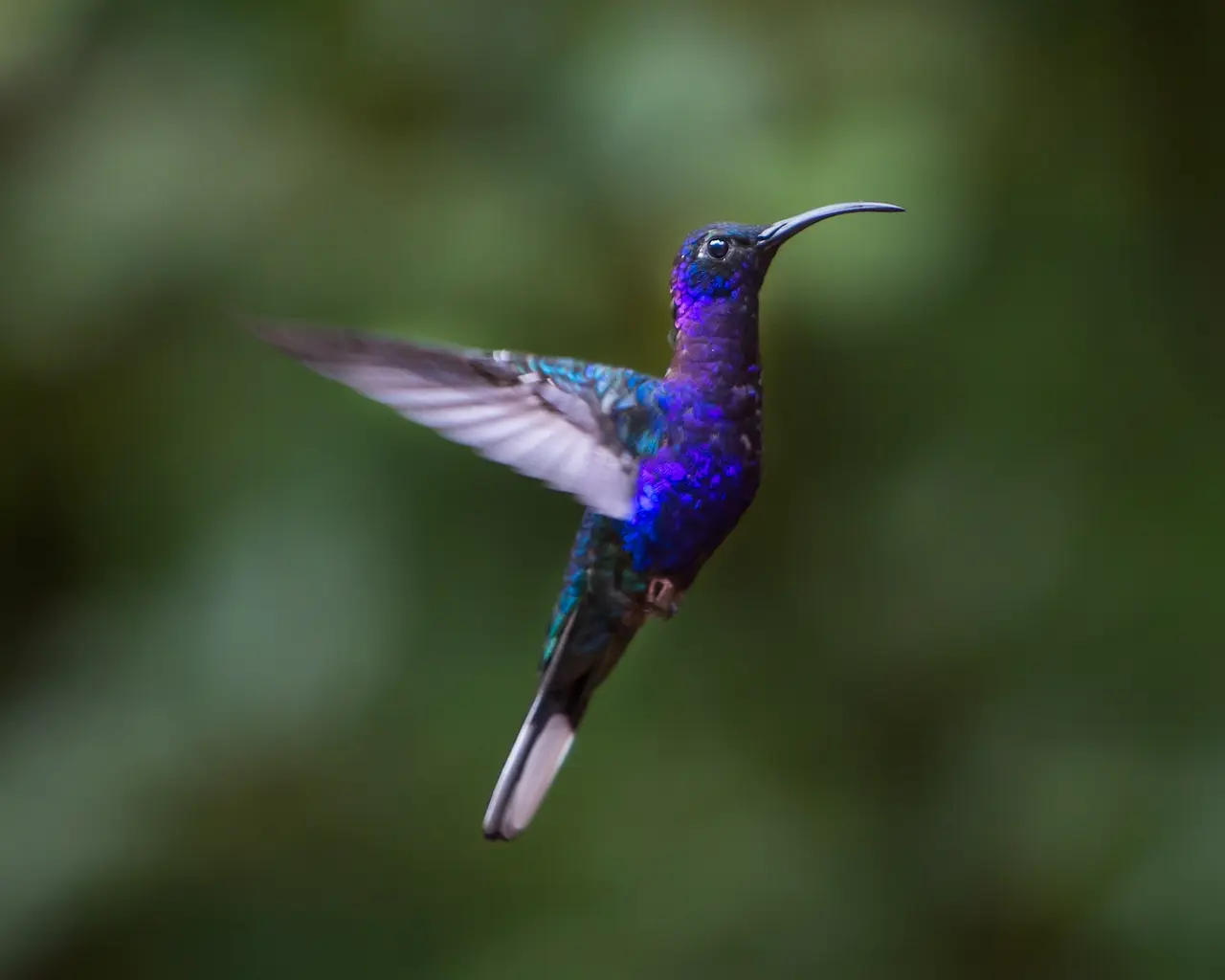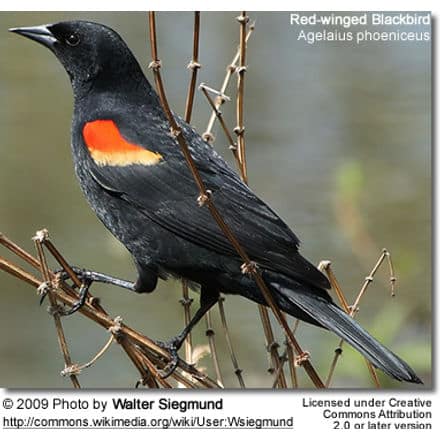Buff-tailed Sicklebills (Eutoxeres condamini)
The Buff-tailed Sicklebills (Eutoxeres condamini) – also known as Condamine’s Sicklebills – are Southern American hermit hummingbirds.
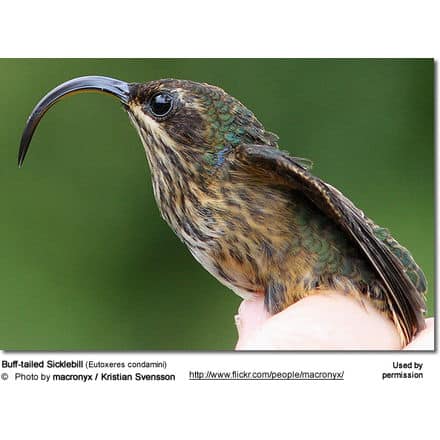

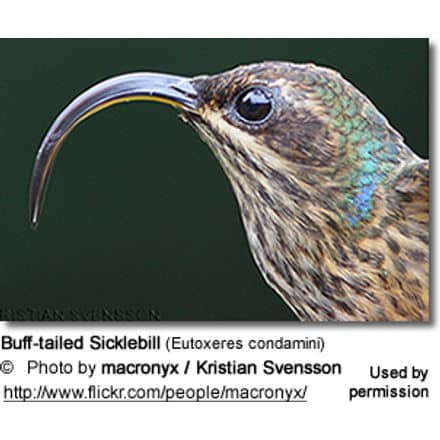
Alternate (Global) Names:
Spanish: Pico de Hoz de Cola Canela, Pico-de-hoz Colicanelo, Picohoz Colicanela … French: Bec-en-faucille de La Condamine, Colibri de la Condamine … Italian: Colibrì beccodifalce codafulva, Falcetto codacamoscio … German: Rotschwanz-Adlerschnabel, Rotschwanz-Sichelschnabel, Rotschwanz–Sichelschnabel … Czech: Kolibrík rusoocasý, kolib?ík rusoocasý … Danish: Okkerhalet Seglnæbskolibri … Estonian: pruun-sirpkoolibri … Finnish: Ruskokoukkukolibri … Japanese: akaokamahashihachidori … Dutch: Roodstaarthaaksnavelkolibrie, Roodstaart-haaksnavelkolibrie … Norwegian: Rusthalesigderemitt … Polish: orlodziobek bialosterny, or?odziobek bia?osterny … Russian: ????????????? ???????????? ??????? … Slovak: srpozobec okrovochvostý … Swedish: Roststjärtad örnkolibri

Distribution / Range
Buff-tailed Sicklebills occur in the lower Andes and adjacent west Amazonian lowlands from southern Colombia and northern Ecuador to Peru and Bolivia.
They have been recorded at elevations from 590-10,800 ft (180-3,300 m).
They are mostly restricted to the undergrowth of humid forested and wooded habitats. They regularly visit plantations, bamboo stands, and open habitats; however, have shown a preference for natural vegetation.
Subspecies ID and Range:
Northern Buff-tailed Sicklebill (Eutoxeres condamini condamini – Bourcier, 1851) – Nominate Race
- Range: East Anmdes from Southeastern Colombia, Ecuador to northern Peru
- ID: Longer beak. Abdomen strongly streaked. Bill is longer, lower belly much streaked.
Southern Buff-tailed Sicklebill (Eutoxeres condamini gracilis – Berlepsch and Stolzmann, 1902)
- Range: Central Peru (east Andes) and northwestern Bolivia
- ID: Shorter beak. Less streaking on the abdomen.
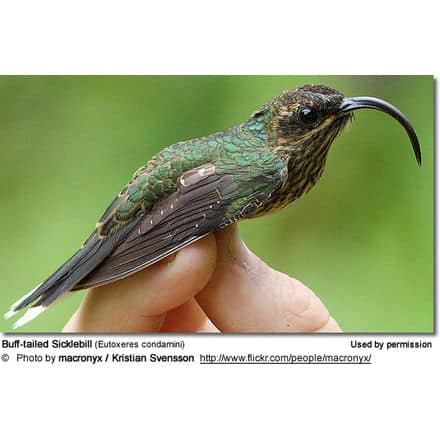
Description
This large hummingbird averages 5-6 in (13–15 cm) in length and weighs about 0.28-0.44 oz (8-12.5 g).
This species was named for its strongly downwards-curved bill and its deep buff outer three rectrices (the long flight feathers of the tail) – which are most easily seen from below.
Males and females look alike in all aspects except for size. Females are about 20% smaller than males and have shorter wing measurements.
The upper plumage is an iridescent dull greenish. The underplumage is whitish, strongly streaked with dusky.
There is a naked stripe on top of the head, but that stripe is usually concealed. There is a faint blue patch on the neck. The tips of the rectrices (the long flight feathers of the tail) are white.
Immature birds can be identified by their light-tipped remiges (pinions). They have hardly any blue on the neck and lack the naked crown stripe of the adult.
Similar Species: The Buff-tailed Sicklebills is easily confused with the White-tipped Sicklebill (E. aquila), which has a more northerly distribution. The Buff-tailed Sicklebill can be identified by its buff outer remiges (= flight feathers – typically only visible in flight).
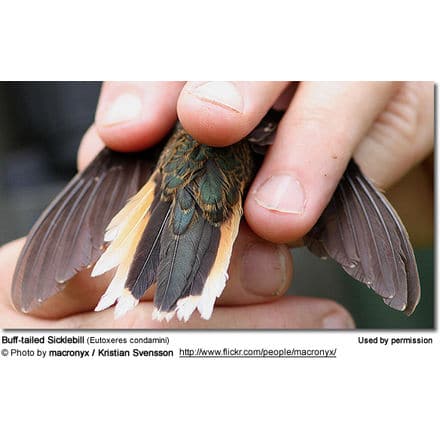
Nesting / Breeding
Hummingbirds are solitary in all aspects of life other than breeding; and the male’s only involvement in the reproductive process is the actual mating with the female. They neither live nor migrate in flocks, and there is no pair bond for this species. Males court females by flying in a U-shaped pattern in front of them. He will separate from the female immediately after copulation. One male may mate with several females. In all likelihood, the female will also mate with several males. The males do not participate in choosing the nest location, building the nest, or raising the chicks.
The female Buff-tailed Sicklebills is responsible for building the remarkable cone-shaped nest which hangs by a single strong string of spiders’ silk and/or rootlets from some overhead support, which could be a branch or the underside of the broad leaves of, for example, Heliconia plants, banana trees or ferns about 3 – 6 ft (1 – 2 m) above ground. However, these unusual nests have been found beneath bridges, in highway culverts and even hanging from roofs inside dark buildings. The nest is often near a stream or waterfall. It is constructed out of plant fibers woven together and green moss on the outside for camouflage in a protected location. She lines the nest with soft plant fibers, animal hair, and feathers down, and strengthens the structure with spider webbing and other sticky material, giving it an elastic quality to allow it to stretch to double its size as the chicks grow and need more room.
The average clutch consists of two white eggs, which she incubates alone, while the male defends his territory and the flowers he feeds on. The young are born blind, immobile, and without any down.
The female alone protects and feeds the chicks with regurgitated food (mostly partially digested insects since nectar is an insufficient source of protein for the growing chicks). The female pushes the food down the chicks’ throats with her long bill directly into their stomachs.
As is the case with other hummingbird species, the chicks are brooded only the first week or two and are left alone even on cooler nights after about 12 days – probably due to the small nest size. The chicks leave the nest when they are about 20 days old.
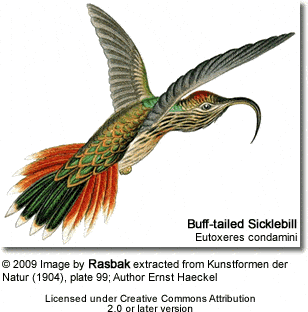
Diet / Feeding
The Buff-tailed Sicklebills primarily feed on nectar taken from a variety of brightly colored, scented small flowers of trees, herbs, shrubs, and epiphytes. They favor flowers with the highest sugar content (often red-colored and tubular-shaped).
Hermits are “trap-line feeders” which means that they visit plants along a long route (in this case of up to 0.6 miles or 1 km) – as opposed to most other hummingbird species which generally maintain feeding territories in areas that contain their favorite plants (those that contain flowers with high energy nectar), and they will aggressively protect those areas. They use their long, extendible, straw-like tongues to retrieve the nectar while hovering with their tails cocked upward as they are licking at the nectar up to 13 times per second. Sometimes they may be seen hanging on the flower while feeding.
Many native and cultivated plants on whose flowers these birds feed heavily rely on them for pollination. The mostly tubular-shaped flowers exclude most bees and butterflies from feeding on them and, subsequently, from pollinating the plants.
They may also visit local hummingbird feeders for some sugar water, or drink out of bird baths or water fountains where they will either hover and sip water as it runs over the edge; or they will perch on the edge and drink – like all the other birds; however, they only remain still for a short moment.
They also take some small spiders and insects – important sources of protein particularly needed during the breeding season to ensure the proper development of their young. Insects are often caught in flight (hawking); snatched off leaves or branches, or taken from spider webs. A nesting female can capture up to 2,000 insects a day.
Males establish feeding territories, where they aggressively chase away other males as well as large insects – such as bumblebees and hawk moths – that want to feed in their territory. They use aerial flights and intimidating displays to defend their territories.
Metabolism and Survival and Flight Adaptions – Amazing Facts
Beauty Of Birds strives to maintain accurate and up-to-date information; however, mistakes do happen. If you would like to correct or update any of the information, please contact us. THANK YOU!!!

